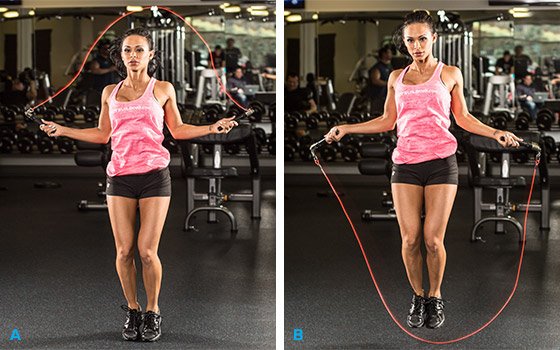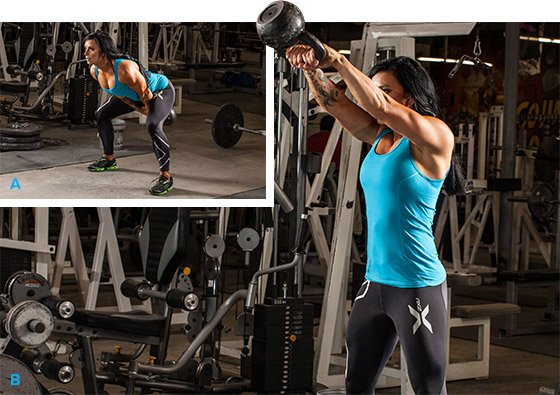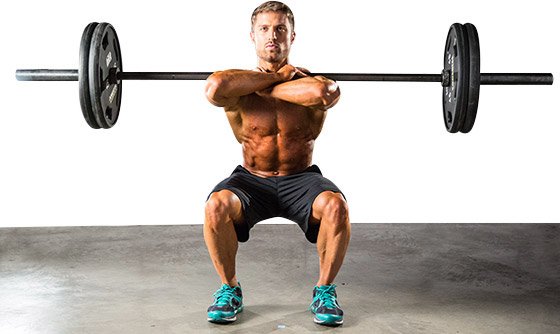A Fat-Loss Five sequence consists of five exercises performed back to back in a circuit. This circuit is developed to be a simple—but not easy—training formula to follow. It's designed to be a fully comprehensive training formula that covers all of the bases. There are two basic components to the Fat-Loss Five circuit: four strength exercises and one total-body cardio exercise.
While you cycle through strength exercises, the sequencing of the Fat-Loss Five circuit creates a constant cardiorespiratory effect. Whenever you perform any strength exercise, your body pumps more blood to the muscles involved in the movement. By performing an upper-body exercise, followed by a lower-body exercise, followed by a core exercise, you constantly change where your body must increase blood flow.
Additionally, finishing each circuit of strength exercises with a burst of total-body cardio interval exercise keeps this cardio-respiratory effect going even longer.
Here are the five categories that make up a Fat-Loss Five circuit:
- Upper-body pushing exercise
- Upper-body pulling exercise
- Lower-body leg- or hip-oriented exercise
- Core exercise
- Cardio exercise
The beauty of the Fat-Loss Five circuit is its simplicity and versatility. As I explain in my new book "Strength Training for Fat Loss," you can plug in virtually any exercise you want as long as it fits in the five categories.
Ingredient 1: Upper-Body Pushing Exercise
The purpose of these exercises is to incorporate the muscles of the chest, shoulders, triceps, and torso in order to maintain a stable body position.
Here's a list of the top five exercises I suggest for this category:
Forward Lunge + Chest Press Exercise With Resistance Bands
Watch The Video - 01:16
Ingredient 2: Upper-Body Pulling Exercise
The purpose of these exercises is to incorporate the muscles of the back, shoulders, biceps, and torso in order to maintain a stable body position.
Here's a list of the top five exercises I suggest for this category:
- Wide-grip band row
- Band swimmers
- Alternate-arm band row
- Suspension row (low elbow or wide elbow)
- Suspension Y-pull
Suspension Y Lift
Watch The Video - 00:11
Ingredient 3: Lower Body Exercise
You can choose either a leg-oriented or hip-oriented lower-body exercise to fill this category. The purpose of these exercises is to incorporate the muscles of the legs, glutes, and torso in order to maintain a stable body position.
Here's a list of the top five exercises I suggest for this category:
- Front or back squat (with barbell)
- Swing (with kettlebell or dumbbell)
- Lateral lunge
- Frog jump
- Alternate-leg step-up (with dumbbell)
Push Up with Frog Jump
Watch The Video - 00:10
Ingredient 4: Core Exercise
The purpose of these exercises is to focus on the abdominal and oblique musculature while also incorporating the hips and shoulders, which, as mentioned earlier, has been shown to be a more effective way of training the abdominal muscles compared with trying to isolate them.
Here's a list of the top five exercises I suggest for this category:
Angled Barbell Rainbow
Watch The Video - 02:17
Ingredient 5: Cardio Exercise
Although I don't recommend using these exercises as long-duration, steady-state cardio in the workout programs provided in my book, they are added in short duration within Fat-Loss Five circuits to boost their effectiveness.
They are kept to short 1-2-minute intervals, which drastically reduces the impact on your joints that they create when performed for extended lengths of time.

Rope Jumping
The cardio options for the Fat-Loss Five include shadowboxing or kickboxing, rope jumping, running, stationary bike (an Airdyne bike is preferred), rower, reaction ball, elliptical trainer, and VersaClimber.
Fat-Loss Five and Bilateral Exercises
Although unilateral exercises can certainly be implemented within a Fat-Loss Five, these circuits run smoother when they use purely bilateral exercises or alternating-limb exercises such as lunges or step-ups (where you switch legs on each rep).
Also, compound movements like squats, push-ups, chin-ups, and barbell rows are better in Fat-Loss Five circuits instead of smaller, single-joint exercises (e.g., biceps curls, triceps extensions).
Compound movements create a better metabolic training response than single-joint actions because they involve more muscles, and the goal of the Fat-Loss Five protocol is to maximize the metabolic effect of every rep, every circuit sequence, and every workout.

THE FAT-LOSS FIVE PROTOCOL
A full Fat-Loss Five circuit is 4 minutes of total work time with 1 minute of rest time, or 5 minutes total. Thus, 2 rounds last a total of 10 minutes and 3 rounds last a total of 15 minutes. Now you can see where the name Fat-Loss Five comes from: There are five exercises and each circuit takes exactly 5 minutes. As you'll see in the workouts, you'll typically perform 2-3 rounds of a given Fat-Loss Five circuit.
Each of the four strength exercises in a Fat-Loss Five circuit is performed for 30 seconds. You then rest 15 seconds before starting the next strength-based exercise. However, the total-body cardio interval, which is done last, is performed for 1-2 minutes. This means that as you become fitter, you may not need to take a complete rest for 60 seconds between circuits. Instead, you may want to do a longer active recovery by extending your cardio interval from 1 minute to 2 minutes, and then going directly into your next circuit.

Kettlebell Swing
You never stop moving. It's still 5 minutes either way you spin it; you do a minute of cardio and take a minute break before you start your next circuit round, or you do 2 minutes of cardio and then start your next circuit round. Of course, eliminating full rest breaks will make your workouts even more productive because you do more activity in the same time frame.
There are two intensities to consider for the Fat-Loss Five circuit: the total intensity of the entire circuit and the working intensity of each exercise within a given circuit. During the strength exercises within a circuit, you should be able to complete the entire 30 seconds of work time with good exercise form and at a fairly consistent tempo from what you started with.
On a scale of 1 to 10 (with 10 being working very hard), at the end of each strength exercise you should be working at around a 7 or 8. Also, because the strength exercises are performed at a higher intensity than the total-body cardio exercise, they're performed for a shorter amount of time—like 30 seconds.
The goal is to complete as many reps as you can within the 30 seconds. However, never sacrifice movement quality for quantity. If fatigue begins to interfere with your exercise form, simply perform your reps more slowly or reduce the range of motion (e.g., don't go as deep on squats or push-ups) in order to make the exercises easier and more manageable to maintain proper control.

Front Barbell Squat
For the cardio interval, use a pace that gets you at or around 70-80 percent of your max heart rate. By the time you're about to begin the next round of the circuit, you should feel mostly recovered. If you can get out a full sentence without breathing heavily (huffing and puffing), you're good to go into your next round. But, if you're still sucking wind after a 60-second break between circuits, you need to reduce the intensity of your cardio interval.
After you perform 2-3 rounds of the same exercises in a given Fat-Loss Five circuit, the strength exercises change, but the cardio exercise remains consistent throughout the entire workout, no matter how many times the strength exercises change.
Keeping the cardio drill the same allows you to develop a consistent rhythm throughout the workout, while changing the strength moves every 2-3 rounds creates enough variety to keep things interesting and helps stimulate your muscles in a variety of ways.







































